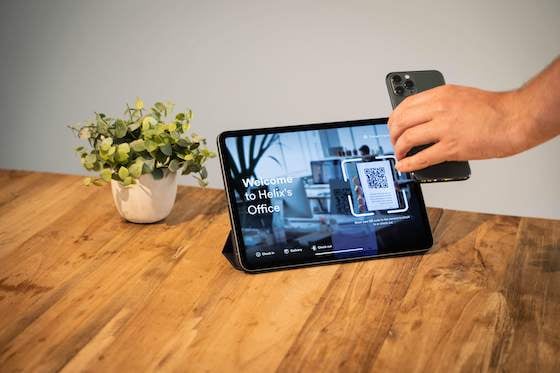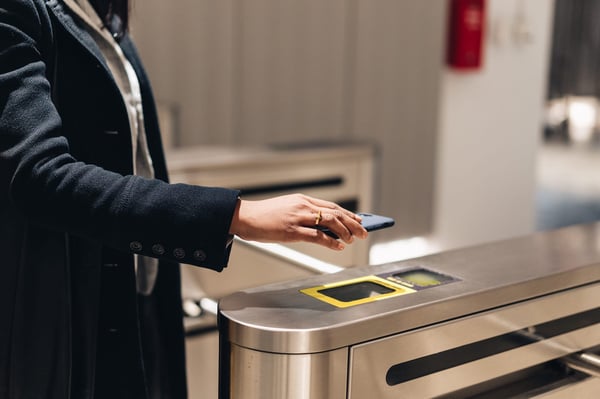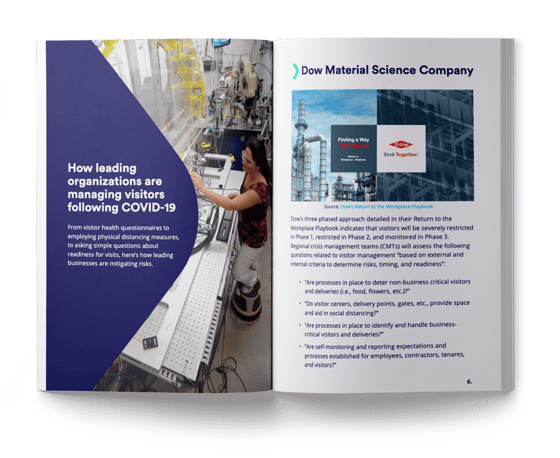I joined Proxyclick a few months ago and when I was finally able to enter the office last week, I met some of my colleagues in rather exceptional circumstances. First, there weren’t many people there. There’s a strict limit to how many of us can be in the office.
Those who were there were wearing masks and disinfecting surfaces they touched. When we had lunch, we ate behind plastic sheets.
It was a surreal experience, but one which after spending months locked down with a toddler, I much appreciated. It also really brought home just how much COVID-19 has changed the way things work.
In this post, I’ll look at how different companies are handling the return to work, share emerging best practices, and invite you to dive deeper in our Return Ready playbook.
Developing a ‘Return Ready’ playbook
It’s difficult to predict just how long-lasting an impact this pandemic will have, but what is clear is that it’s already been the catalyst for many changes.
On a global level, institutions such as the World Health Organization (WHO), the European Union information agency for occupational safety and health (OSHA-EU), the Occupational Safety and Health Administration (OSHA), and others have issued guidelines to stop the spread.
These guidelines have in turn been interpreted by national and local authorities. Singapore, for example, developed its TraceTogether app, while New York made health screening for visitors and employees mandatory for businesses.
Speaking of businesses, here, too, many leading companies have dedicated significant resources to developing their own ‘back to work’ playbooks.
Ford, General Motors, Ford, and DHL , to name a few, have all created step by step guides to get their facilities up and running again.
While the level of detail found in each return-to-work playbook varies, managing employee and visitor flows is always pinpointed as playing a pivotal role in keeping workplaces safe.
Some measures, such as restricting access, employee and visitor screening, and maintaining an auditable logbook, were found throughout most of the playbooks. And I’m pleased to say that they are all covered by Proxyclick, and led to the development of our Prepare, Prevent, Protect framework (more on this below).
What our customers told us
As COVID-19 began to emerge as a global threat, many of our customers began to alter their people flows. Brooklyn Navy Yard, for example, was able to adapt its set up to offer an almost fully touchless check-in flow.
“Proxyclick has been super helpful; I’m not sure what we would’ve done otherwise if we didn’t have a system that was that convenient and easy to use. It’s really been seamless in getting people into the Yard during COVID-19.” - Marc A. Cecere, Director of Applications, Brooklyn Navy Yard
Sodexo and L'Oréal were able to quickly change their employee and visitor workflows and develop health and safety questionnaires to help them determine who could safely enter the building.
“Since we’re not just using Proxyclick here in Singapore but also in other countries, we can push out largely similar questions, though they will be localized from country to country. At least this will be easy to manage and control - everything can be pushed across various locations on the fly, via the internet.” - Patrick Foong, CIO, Sodexo APAC
L'Oreal presented their new flows to management and rolled them out to 34 sites within half an hour. And in 2020 roundtable discussions, our customers Metlife, Ernst & Young, and IDEMIA shared important insights on how they've managed employees and visitors as they've reopened their offices.
At this point, it’s worth mentioning that helping companies manage pandemics is not new for Proxyclick. I was pleased to discover that we had developed a health screening system in the past, designed to keep anyone with symptoms of Ebola out of the workplace during the outbreak in 2014.
But, of course, we wanted to do more.
Our product and customer success teams worked hand-in-hand with our clients to tackle new challenges. The direct result of this collaboration was our touchless check-in process. As its name suggests, this combination of features means employees and visitors can check-in and out without touching anything.

No compromising on security or privacy
We also listened when businesses voiced security and privacy concerns regarding the concept of a touchless check-in.
Proxyclick has always had a firm commitment to both security and privacy. Our track record and privacy certifications speak to that and compromising on either was never an option, especially in light of heightened security risks and dealing with sensitive health data.
Proxyclick integrates with your access control system (ACS), to enable you to create a secure, QR code-based check-in process. This way, you only provide a QR code to pre-approved employees and visitors, who have met the health and safety criteria determined by your questionnaire. Anyone who does not have a QR code and meet the criteria won’t be allowed in.

Data privacy has always been a topical, and no more so than now. Asking employees, contractors, and visitors to provide information about their health and potential whereabouts, is not to be taken lightly.
And that goes beyond complying with international regulations, but also respecting the trust your employees and visitors place in your business when they share sensitive information. Our customizable, automated data deletion feature ensures you don’t keep anything for longer than you have to.
 I won’t get into more detail here, but I invite you to visit our touchless check-in page to see how it all comes together.
I won’t get into more detail here, but I invite you to visit our touchless check-in page to see how it all comes together.
Where we're headed next
Throughout this pandemic, the one constant has been uncertainty. Uncertainty around its impact and how best to minimize it.
And while we learn more about the virus every day, it is likely that rules and regulations will continue to evolve rapidly.
I’m proud that we’ve been able to help our clients adapt each step of the way. From implementing strict “essential visitor” only policies to pre-visit health screenings, and tailored employee and visitor flows that reflect local rules and regulations.
So what have we done with all this acquired knowledge? Well, in addition to developing a solution that can adapt to rapidly changing regulations, we wrote it all down and created a Return Ready playbook.
Our Prepare, Prevent, and Protect framework is based on international guidance, business best practices, and conversations with our customers.
I hope you find it valuable.
For more on how to get Return Ready, download our free playbook below.

